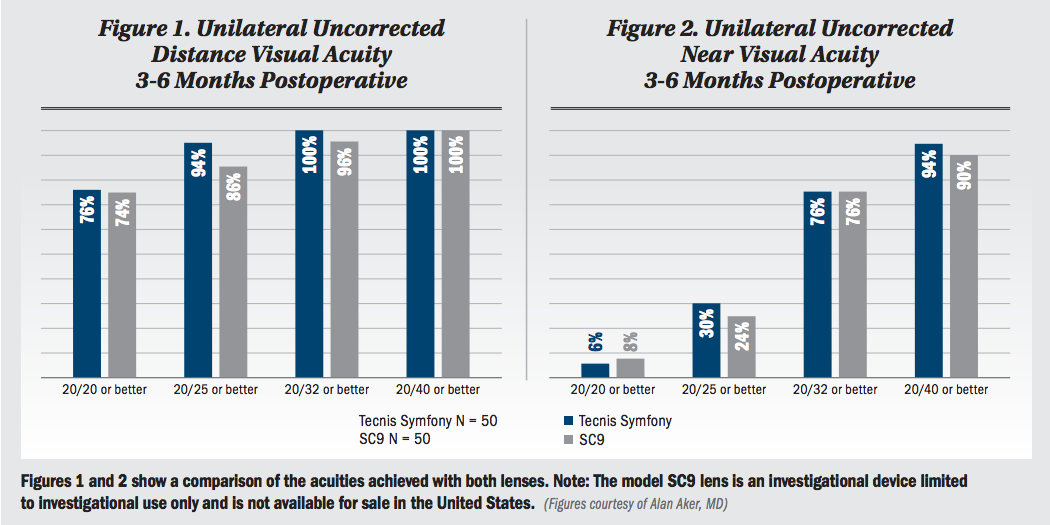News
Article
Physicians on quest to end dysphotopsias in premium IOLs
Author(s):

Editor's Note: The model SC9 lens is an investigational device limited to investigational use only and is not available for sale in the United States.
In the face of continuing reductions in surgeon fees for cataract surgery (averaging $2,800 in 1980 to $560 in 2019), there is interest in procedures not covered by Medicare. These are generally referred to as premium-channel products, and surgeons can bill for these upgrades as private-pay procedures.
With cataract surgery being one of the most commonly performed ophthalmic procedures, one would think that presbyopia-correcting IOLs (premium IOLs) that can provide uncorrected distance and near vision without correction would be widely embraced by both patients and surgeons.
Though presbyopia-correcting IOLs have been available since 2005, the current market penetration of these premium IOLs remains low, however. Patients are accustomed to paying for “upgrades” and there is growing demand among baby boomers for greater freedom from glasses following cataract surgery.
Postop visual disturbances

Despite an increased interest among patients for spectacle independence following cataract surgery, some surgeons may remain reluctant to implant these premium IOLs because of postoperative issues such as halo, glare, and other visual disturbances known as dysphotopsias.
Because of these complaints, currently available premium IOLs are sometimes removed.
This lens exchange or lens replacement surgery is something some surgeons may be uncomfortable performing.
In addition, managing these premium IOL patients can be challenging because of additional chair time.
Because of issues such as loss of contrast as well as glare and halos, previously approved technologies have been revisited over the years to reduce patient complaints and to improve utilization of presbyopia-correcting IOLs.
With the availability of the Tecnis Symfony IOL (Johnson & Johnson Vision) to the U.S. market, surgeons were eager to try this new lens, an extended-depth-of-focus lens without the dysphotopsias that may have been seen with other multifocal IOLs.
When we first began implanting the Symfony IOL, eight of our first 100 implants were removed and exchanged because of patient dissatisfaction. These exchanges were performed due to issues relating to either quality of vision or glare and halos.
Patient education about these challenges and careful patient selection has helped to reduce the number of explants we have had to perform.
Because of excellent results achieved, we continue to implant the Symfony IOLs, but many patients continue to complain of postoperative issues, such as quality of vision, and especially difficulty driving at night.
SC9 study
We were asked to participate in the ongoing FDA study of the SC9 lens, developed by Stuart Cumming, MD, inventor of the Crystalens (Bausch + Lomb) and founder of CORD (Cumming Ophthalmic Research and Development).
The SC9 is a biconvex optic with a single focal point that affords excellent distance, intermediate, and near vision as a result of its unique design, which consistently places the optic deep in the capsular bag.
Our first SC9 was implanted in May 2017, and we are pleased to report that this lens provides our patients with excellent distance, intermediate, and near vision.
Perhaps the most significant aspect of the device is that, in our experience, it provides excellent vision without drawbacks that may be associated with presbyopia-correcting IOLs currently available to our patients in the United States.
Impressed with the results in our study patients, we decided to compare the SC9 in our unmasked study patients with a similar group of Symfony patients.
Our criteria for patient selection for any premium IOL are almost identical to the criteria for inclusion in the SC9 study.
Each patient selected for a premium IOL at our center has to have the potential for 20/20 vision and no retinal pathology.
Visual acuities are impressive with both lenses, but perhaps the most compelling results have to do with patient satisfaction and the presence or absence of visually disturbing glare and halos.
One patient in this study required an additional surgery to remove his Symfony lens. Despite excellent distance and near vision, the lens was removed because of his inability to drive at night due to glare and halos.
Seeking freedom from glasses
With today’s advanced formulas and improved standard lenses, ophthalmologists can correct myopia, hyperopia, and astigmatism. This means it may be possible to greatly reduce the need for glasses for distance for many patients with healthy eyes.
The formulas used to select the lens power for an IOL are excellent. In the absence of retinal or corneal issues, we expect each of our patients to be seeing well enough to drive without glasses following cataract surgery.
The challenge at hand
Intermediate and near vision without glasses and without halos and glare remains a challenge. By virtue of their design, multifocal and so-called EDOF lenses may put some patients at risk for bothersome glare and halos and dysphotopsias following implantation. Manufacturers have revisited various multifocal designs to reduce issues with nighttime glare.
Given a new option to provide excellent acuity at distance, intermediate, and near without having to be concerned with postoperative complaints of loss of contrast, glare, and halos would be a game-changer in terms of utilization.
In addition, such a lens would be welcomed by patients as well as ophthalmic surgeons in the United States and internationally.
Diving deeper
Our mini-study allowed us to compare objective and subjective results of 50 SC9 lenses and 50 Symfony lenses at 3 to 6 months postoperatively in our patients. We have achieved excellent results in both groups, and the quality of vision and the absence of symptoms such as glare and halos in patients with the SC9 is impressive.
Every patient we have implanted with the SC9 has been pleased with the outcome and no patient has complained of significant issues with glare and halos. The SC9 delivers excellent distance, intermediate, and near vision by virtue of the unique design of this new premium IOL.
The longitudinally rigid-lens design consistently places the optic of the SC9 deeper in the eye than other lenses. This was confirmed by Jonathan Soiseth, MS, after an analysis of the depth of SC9 placement in our study patients.
This method of action that places the IOL closer to the nodal point in the eye. Because of this, patients may achieve a dramatic increased depth of focus. This results in excellent distance, intermediate, and near vision without bothersome glare and halos since there are no diffractive or refractive rings on the SC9 optic.
Alan Aker, MD
E: yodeler@akerkasten.com
Dr. Aker is co-founder and medical director of the Aker Kasten Eye Center in Boca Raton, FL. Dr. Aker has no financial interest in this subject matter.
Newsletter
Don’t miss out—get Ophthalmology Times updates on the latest clinical advancements and expert interviews, straight to your inbox.
2 Commerce Drive
Cranbury, NJ 08512
All rights reserved.




